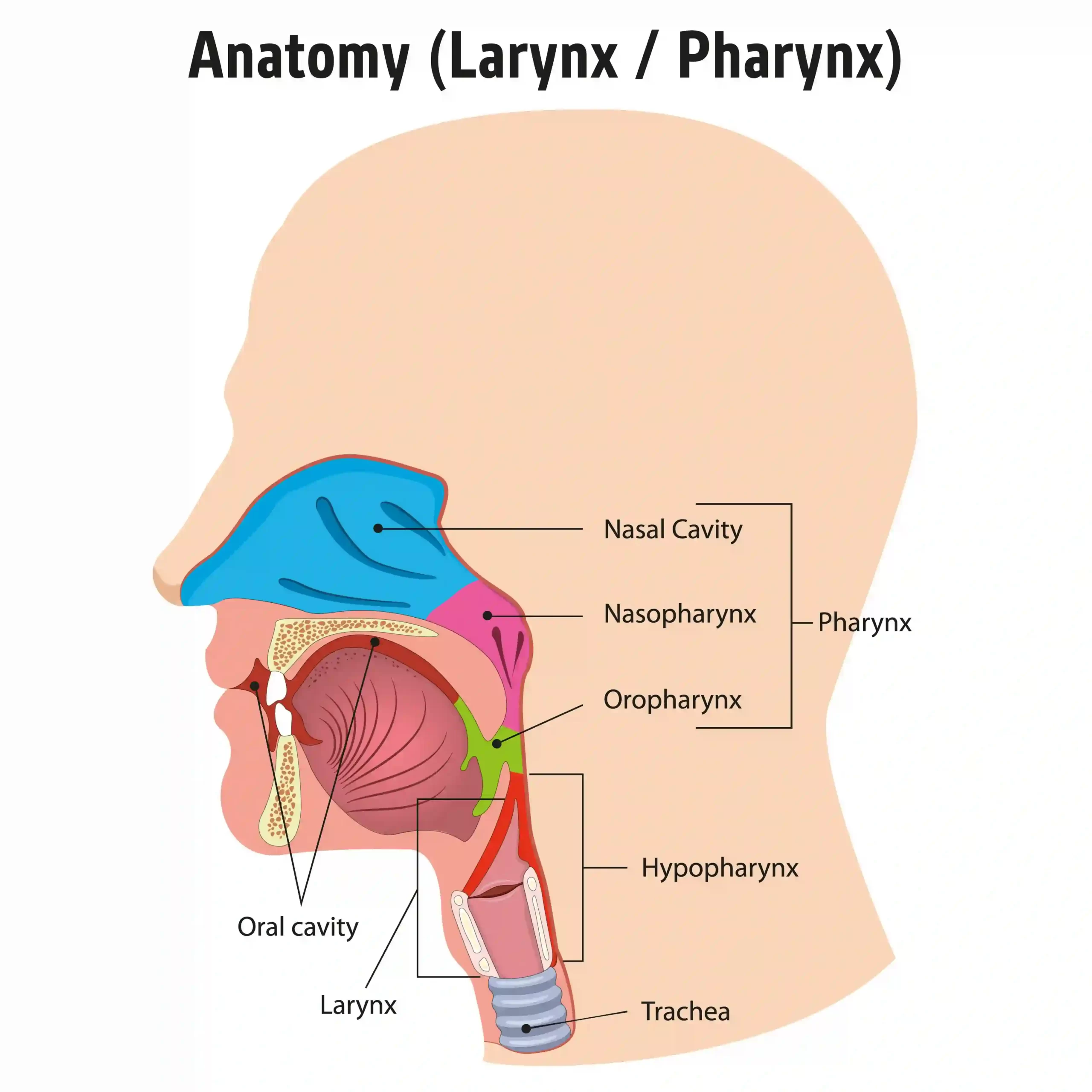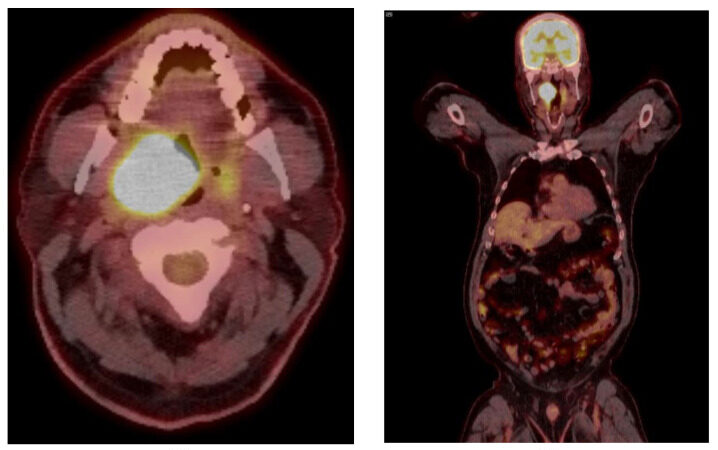Throat Cancer

Throat cancer refers to malignant tumours that develop in the throat (pharynx), voice box (larynx), or tonsils. It’s a type of head and neck cancer that can affect speech, swallowing, and breathing. Understanding the types, causes, risk factors, symptoms, diagnosis, and treatment of throat cancer is essential for early detection and effective management.
What is Throat Cancer?

Throat cancer is any cancerous tumour that grows in your throat (pharynx) or voice box (larynx). The throat is a tube that starts behind your nose and ends at the neck. The throat is sectioned into three parts:
- Nasopharynx: Upper part of the throat
- Oropharynx: Middle part of the throat
- Hypopharynx: Lower part of the throat
Right under the lower pharynx is the voice box, which contains vocal cords that allow you to speak. Cancer can occur in any part of the throat and is categorised as different types of cancer. Regardless, most throat cancers in Singapore will involve surgery as a treatment plan.
Types of Throat Cancer
Throat cancer is categorised based on the location and type of cells where the cancer begins.
Laryngeal Cancer
- Usually found at the voice box, this cancer can start in different parts of the larynx.
- Typically occurs in those aged 55 and beyond.
- Prevalence among men is higher than women.
- Patients who are diagnosed with this form of cancer often have a 5-year survival rate* between 46% to 72%.
Oropharyngeal Cancer
- Usually found in the middle part of the throat (Oropharynx), this cancer usually starts right behind your mouth.
- It generally occurs in patients who are aged 60 and older.
- Men are twice more likely to develop this cancer than women.
- The 5-year survival rate for patients with this cancer is 50%.
Hypopharyngeal Cancer
- Usually found at the lower part of the throat (Hypopharynx), this cancer typically appears above your oesophagus (food pipe) and windpipe.
- This is not a common cancer found in most people.
- The 5-year survival rate for this cancer varies between 28% to 61%.
Nasopharyngeal Cancer
- Usually found at the upper part of the throat (Nasopharynx), this is a common type of throat cancer that affects the throat’s starting point just behind the nose.
- It is also called Nasopharyngeal Carcinoma.
- This type of nose/throat cancer ranks amongst the top 10 cancers in Singapore and Asia.
- 5-year survival rates for patients with this cancer range from 49% to 82%.
Supraglottic Cancer
- Usually found at the upper part of the voice box, this cancer affects the epiglottis (a cartilage that keeps food from going into your windpipe).
- About one-third of all laryngeal cancers start from here.
- Survival rates of patients after 5 years since diagnosis range from 30% to 61%.
Glottic Cancer
- Usually found in the vocal cords.
- More than 50% of all laryngeal cancers begin from here.
- The 5-year survival rate is relatively high, between 45% to 84%.
Subglottic Cancer
- Usually found at the lower part of the voice box, it is a rare form of throat cancer that can trigger laryngeal cancer, accounting for approximately 5% of all laryngeal cancer cases.
- The patient’s 5-year survival rate ranges from 38% to 59%.
*The 5-year survival rate reflects the percentage of patients still alive five years after cancer diagnosis.
Symptoms of Throat Cancer
Different cancer types may cause varied symptoms based on their location and how they affect the surrounding structures. The stage of throat cancer may also influence the kind of symptoms patients experience.
There are four stages to throat cancer, with a precursor stage where you may have abnormal cells that can turn cancerous.
- Stage 0: Involves abnormal cells that can potentially become cancerous, also known as ‘carcinoma in situ.’
- Stage I: The cancer is in its very early stages and is still localised to the throat area, typically smaller than 2 centimetres.
- Stage II: By this stage, the cancer cells are usually between 2 and 4 centimetres in size. They may not have spread to other areas like the lymph nodes, and the vocal cords continue to function normally.
- Stage III: The cancerous tumour is likely larger than 4 centimetres and has spread to nearby lymph nodes. Your vocal cords may no longer move, and the cancer could be affecting other parts of your throat.
- Stage IV: At this stage, the cancer may vary in size but has spread to other areas, including the neck, jaw, mouth, and distant parts of the body, like the lungs.
Common signs of throat cancer include:
- Sore throat that persists for more than two weeks
- Pain or difficulty swallowing food (dysphagia)
- Changes in your voice, such as hoarseness, that last for more than two weeks
- Lump in throat sensation
- A lump or mass in the neck
- Sudden unexplained weight loss
Other signs include:
- Shortness of breath or trouble breathing
- Difficulty opening the mouth or moving the tongue
- Pain that lasts for more than two weeks.
- Coughing up blood
While the above symptoms can be caused by throat cancer, it is not always the case. Early signs of throat cancer may not appear until Stage 1. Therefore, any signs suggesting throat cancer should be taken seriously. These cancers often grow quickly, hence, early diagnosis and treatment provide the best chance for effective removal and maintaining a good quality of life. Symptoms of ear, nose and throat (ENT) conditions often overlap. For peace of mind, consult a throat specialist in Singapore if you experience any symptoms for over two weeks. In most cases, your symptoms are indicative of less serious conditions.
Causes of Throat Cancer
The main cause of throat cancer is a mutation in the genetic makeup that results in abnormal cells that continue to grow. While the trigger of such mutation is still unknown, there are known risk factors that contribute to the onset of throat cancer:
- Tobacco Use: Smoking or consuming products containing tobacco significantly increases the risk.
- Alcohol Consumption: Excessive consumption of alcohol use is known to contribute to higher risks.
- Human Papillomavirus (HPV): Certain HPV infections are linked to oropharyngeal cancers.
- Poor Nutrition: A diet with insufficient fruits and vegetables may increase the risk.
- Gastroesophageal Reflux Disease (GERD): Frequent acid reflux can cause irritation and changes in the throat lining.
- Exposure to Asbestos or Other Chemicals: Certain occupations that involve inhaling hazardous substances can increase the risk
- Family history of cancer: A family history of cancer may increase the likelihood of developing throat cancer.
- Age: People over the age of 55 are at a higher risk of developing throat cancer.
How Does a Throat Specialist in Singapore Diagnose Throat Cancer?

There are various ways for a throat specialist to confirm the presence of throat cancer. Diagnostic tools typically utilised include:
- Physical examination: Your doctor will check for lumps that appear on the outside of the neck and may insert a gloved finger to examine the inner mouth and throat area.
- Laryngoscopy/Naso-endoscopy: A flexible tube with a camera attached may be inserted via the nose to check for any visible lumps in the throat.
- Biopsy: Collection of a tissue sample for microscopic examination to confirm cancer.
- Imaging Tests: To help visualise the inside of your throat and determine the location, size and spread of cancer, your doctor may request a CT scan, MRI or X-ray.
- Positron emission tomography (PET) Scan: This is also an imaging test that tests for the function of organs or systems in your body, commonly used to check whether cancer has spread to other areas.
What are the Treatment Options Available for Throat Cancer?
Treatment of throat cancer in Singapore may involve one or more treatment approaches depending on its stage. In general, the treatment options available include:
- Surgery: Removal of tumour and some surrounding healthy tissue. Complex cases may require more extensive surgery, including partial or total removal of the larynx (laryngectomy) or pharynx (pharyngectomy).
- Radiation Therapy: Utilises high-energy beams to target and kill cancer cells. It can be used alone for early-stage cancers or paired with chemotherapy for complex cases.
- Chemotherapy: Involves medications to kill cancer cells, often used alongside radiation therapy. It is commonly administered intravenously (via injection in the vein).
- Targeted Therapy: Involves drugs that target cancer cell abnormalities.
- Immunotherapy: Uses the body’s immune system to fight cancer, an option for some complex or recurrent throat cancers.
Early throat cancers can typically be managed with a single treatment approach, either radiation therapy or surgery. For later-stage cancer, patients may require a combination of treatments, especially if the cancer cells have spread.
When Should You See a Throat Specialist in Singapore for Throat Cancer?
Throat cancer poses serious health challenges but can often be treated successfully, especially if diagnosed early. Awareness of the risk factors, symptoms, and the importance of early detection is key to improving outcomes.
If you experience persistent throat symptoms, particularly if you have risk factors for throat cancer, it’s crucial to visit an ENT specialist in Singapore promptly. Book an appointment with Dr Ker Liang at Aglow ENT Centre, an experienced ENT specialist capable of performing surgical procedures as part of treatment, including throat cancers in Singapore.
References
- Cleveland Clinic. Throat Cancer. Cleveland Clinic. Published 2023. Accessed January 17, 2025. https://my.clevelandclinic.org/health/diseases/23136-throat-cancer
- American Cancer Society. Survival Rates for Laryngeal and Hypopharyngeal Cancers. American Cancer Society. Published 2023. Accessed January 17, 2025. https://www.cancer.org/cancer/types/laryngeal-and-hypopharyngeal-cancer/detection-diagnosis-staging/survival-rates.html
- WebMD. Throat Cancer: Symptoms and Treatments. WebMD. Accessed January 17, 2025. https://www.webmd.com/oral-health/throat-cancer-symptoms-treatments#1-3
- Cancer Council Australia. Throat Cancer. Cancer Council Australia. Published 2023. Accessed January 17, 2025. https://www.cancer.org.au/cancer-information/types-of-cancer/throat-cancer
Frequently Asked Questions
How to prevent throat cancer?
While there is no guaranteed measure, certain lifestyle choices can significantly lower the risk of throat cancers:
- Avoid Tobacco and Limit Alcohol: These are the most significant modifiable risk factors for throat cancer.
- HPV Vaccination: Recommended for children and young adults to prevent HPV-related oropharyngeal cancers.
- Well-balanced Diet: Increased intake of fruits and vegetables may help lower the risk.
- Regular Dental Check-ups: Oral health can impact overall health, including the risk of throat cancer.
Can a nasal endoscopy detect throat cancer?
Yes, a nasal endoscopy can detect throat cancer.
How to check for throat cancer at home?
You can check for noticeable lumps in the throat area. However, for a proper diagnosis, you must visit an ENT specialist.
How long does it take to get throat cancer?
The time it takes for cancer to develop varies from person to person and depends on the nature of the cancer cells.
Can throat cancer spread to other parts of the body?
When undetected or left untreated, cancer cells can spread to other body parts from the throat.
What does early throat cancer feel like?
Early throat cancer may cause symptoms like a persistent sore throat, hoarseness, difficulty swallowing, or a lump in the neck. These symptoms are often subtle and may be mistaken for less serious conditions.
How long can you have throat cancer without knowing?
Throat cancer can go unnoticed for months or even years. This is especially during the early stages when symptoms are mild or resemble common conditions like a cold or sore throat.
What can be mistaken for throat cancer?
Conditions such as laryngitis, acid reflux (GERD), tonsillitis, or even allergies can cause similar symptoms and may be mistaken for throat cancer.
How do you know if your throat is normal?
A normal throat is typically free from persistent pain, difficulty swallowing, or noticeable lumps. If symptoms like hoarseness, swelling, or a sore throat persist for more than two weeks, it’s important to consult a doctor.
At what age is throat cancer common?
Throat cancer is most commonly diagnosed in individuals over the age of 50. However, risk factors like smoking or HPV can increase the likelihood at a younger age.
Assistant Professor Ker Liang has a passion for teaching and is an Assistant Professor with NUS Yong Loo Lin School of Medicine (YLLSOM). As the NUS-NUH Otolaryngology Department Undergraduate Medical Director, Dr Ker Liang supervises the training of medical students from YLLSOM, NUS. She is actively involved
in the training of postgraduate junior doctors and residents in the Head and Neck Surgery department. She was conferred with an Undergraduate Teaching Award by the National University Health System in 2016 for her outstanding efforts as an Otolaryngology educator.
Assistant Professor Ker Liang has a passion for teaching and is an Assistant Professor with NUS Yong Loo Lin School of Medicine (YLLSOM). As the NUS-NUH Otolaryngology Department Undergraduate Medical Director, Dr Ker Liang supervises the training of medical students from YLLSOM, NUS. She is actively involved
in the training of postgraduate junior doctors and residents in the Head and Neck Surgery department. She was conferred with an Undergraduate Teaching Award by the National University Health System in 2016 for her outstanding efforts as an Otolaryngology educator.
Lorem ipsum dolor sit amet, consectetur adipiscing
Lorem ipsum dolor sit amet, consectetur adipiscing elit. Ut elit tellus, luctus nec ullamcorper mattis, pulvinar dapibus leo. Lorem ipsum dolor sit amet, consectetur adipiscing elit. Ut elit tellus, luctus nec ullamcorper mattis, pulvinar dapibus leo.
Lorem ipsum dolor sit amet, consectetur adipiscing
Lorem ipsum dolor sit amet, consectetur adipiscing elit. Ut elit tellus, luctus nec ullamcorper mattis, pulvinar dapibus leo. Lorem ipsum dolor sit amet, consectetur adipiscing elit. Ut elit tellus, luctus nec ullamcorper mattis, pulvinar dapibus leo.
Lorem ipsum dolor sit amet, consectetur adipiscing
Lorem ipsum dolor sit amet, consectetur adipiscing elit. Ut elit tellus, luctus nec ullamcorper mattis, pulvinar dapibus leo. Lorem ipsum dolor sit amet, consectetur adipiscing elit. Ut elit tellus, luctus nec ullamcorper mattis, pulvinar dapibus leo.
Lorem ipsum dolor sit amet, consectetur adipiscing
Lorem ipsum dolor sit amet, consectetur adipiscing elit. Ut elit tellus, luctus nec ullamcorper mattis, pulvinar dapibus leo. Lorem ipsum dolor sit amet, consectetur adipiscing elit. Ut elit tellus, luctus nec ullamcorper mattis, pulvinar dapibus leo.
Lorem ipsum dolor sit amet, consectetur adipiscing
Lorem ipsum dolor sit amet, consectetur adipiscing elit. Ut elit tellus, luctus nec ullamcorper mattis, pulvinar dapibus leo. Lorem ipsum dolor sit amet, consectetur adipiscing elit. Ut elit tellus, luctus nec ullamcorper mattis, pulvinar dapibus leo.



